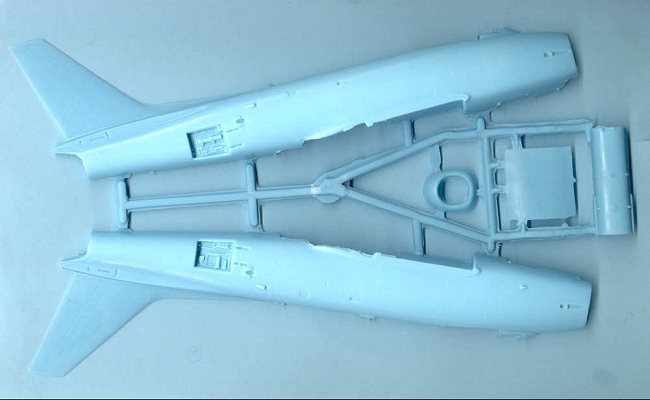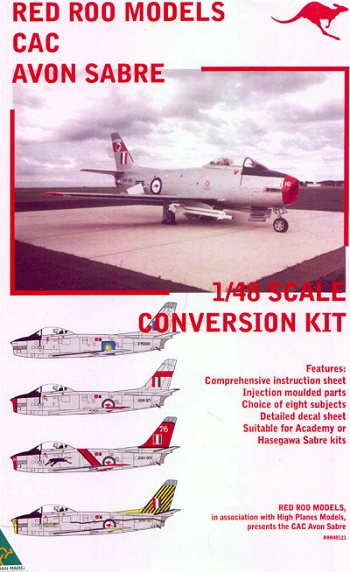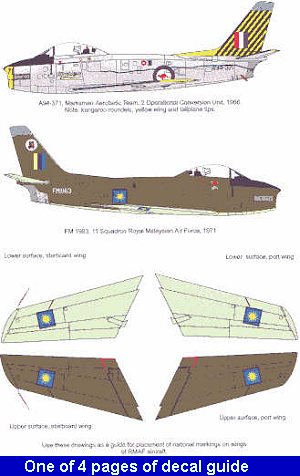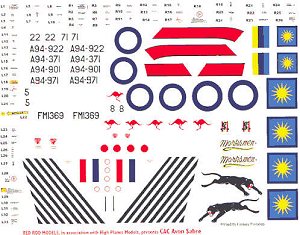
|
SET: |
Red Roo 1/48 Avon Sabre Conversion |
|
FOR: |
1/48 Academy or Hasegawa F-86F |
|
PRICE: |
AUD $27 |
|
REVIEW BY: |
|
|
NOTES: |
Injected fuselage and decals |

 It's safe
to say that the North American F-86 Sabre was the outstanding air superiority
fighter of its generation. The first western aircraft to benefit from German
wartime aerodynamic research into swept wings, the prototype Sabre flown by
North American test pilot George Welch unofficially beat Chuck Yeager and the
X-1 through the sound barrier on one of its very first flights, making the F-86
the first combat airplane capable of supersonic flight, albeit in a dive. Had it
not been for the existence of the F-86, the outcome of the Korean War might well
have been very different. The airplane served many different air forces; as
recently as the late 1970s over 400 were still in first-line service with
several of the world's air forces, such as Japan, the Republic of Korea,
Thailand, Malaysia, and South Africa, and it did not leave these inventories
until the 1980s, close to 40 years after the flight of the first prototype - a
remarkable record.
It's safe
to say that the North American F-86 Sabre was the outstanding air superiority
fighter of its generation. The first western aircraft to benefit from German
wartime aerodynamic research into swept wings, the prototype Sabre flown by
North American test pilot George Welch unofficially beat Chuck Yeager and the
X-1 through the sound barrier on one of its very first flights, making the F-86
the first combat airplane capable of supersonic flight, albeit in a dive. Had it
not been for the existence of the F-86, the outcome of the Korean War might well
have been very different. The airplane served many different air forces; as
recently as the late 1970s over 400 were still in first-line service with
several of the world's air forces, such as Japan, the Republic of Korea,
Thailand, Malaysia, and South Africa, and it did not leave these inventories
until the 1980s, close to 40 years after the flight of the first prototype - a
remarkable record.
The two countries that chose not only to operate Sabres but to produce their own created superior aircraft to the North American original. The Orenda 14-powered Canadair Sabre Mk.6 could show a clean pair of heels to any North American Sabre, while the Avon-powered Commonwealth Aircraft Corporation's CA-27 Sabre would not only show a clean pair of heels to any Canadair Sabre, but could out-shoot any other Sabre built with its twin 30mm Aden cannon armament. Indeed, the Australian Sabre was generally considered the best of all, and there were those U.S. Air Force officers charged with the operational effectiveness of the sharp end of the stick over Southeast Asia in 1965-66 who would have been very happy to have Australian pilots and their Sabres providing fighter escort over North Vietnam, given that the airplane would outperform the MiG-17 the North Vietnamese were then equipped with, which was giving the F-4 Phantom fits in regards to air combat.
The Australians had wanted Sabres as early as 1949, and the RAAF was close to revolt when the government saddled them with the obsolete Meteor for combat in Korea. The government realized its mistake, and in 1951 an agreement was concluded to allow license-built production of the Sabre in Australia. The RAAF - having seen the Sabre in action against the MiG-15 - wanted heavier armament and increased power for theirs. The necessary changes resulted in some radical alterations to the fuselage, since the Avon engine required a larger air intake and - with a weight 400 pounds less than the J-47 - the break in the rear fuselage had to be positioned further aft. Some structural redesign was also necessary for the use of the Aden cannon. In the end, only 40 percent of the original fuselage structure remained when the Australian prototype flew on August 3, 1953.
The first of 22 CA-27 Mk.30s flew July 13, 1954, with the slatted wing of the F-86E. The 6'3" hard edge extension of the F-86F was mated to the airplane with the 21 Mk.31s of 1957; most of the Mk.30s were brought up to this standard. The definitive Mk.32, with the Avon 26 engine and four wing hardpoints, appeared in 1958; 68 were built to bring total CAC production to 112 aircraft.
The Sabre's replacement, the Mirage IIIO, first appeared with 75 Squadron in 1964, but the Sabres continued in operation with 78 Wing at Butterworth, Malaysia, in 3 and 77 Squadrons until the late 1960s; 79(F) Squadron - which so impressed the USAF - operated from Ubon, Thailand, from June 1962 to July 1968. (Thanks to Cliff Viertel, a former 79 Sq pilot for the 79(F) deployment information. Ed)
Red Roo's Conversion Kit:
 Let it be
said that your biplane-loving reviewer has as many books on the Sabre as he does
on the Spitfire, an indication of my regard for this airplane. Model-wise, it is
also the most-numerous jet in my collection. I first tried to make a conversion
for the Avon Sabre some 25 years ago, using a 1/72 Hasegawa kit. The fuselage
had to be sectioned, puttied, sanded over completely, and rescribed totally.
Fortunately, ESCI had a decal sheet that included the Black Panther
demonstration team from 76 Squadron. This difficult conversion took a lot of
work, but I was happy with the result and it even won an award at a contest.
Let it be
said that your biplane-loving reviewer has as many books on the Sabre as he does
on the Spitfire, an indication of my regard for this airplane. Model-wise, it is
also the most-numerous jet in my collection. I first tried to make a conversion
for the Avon Sabre some 25 years ago, using a 1/72 Hasegawa kit. The fuselage
had to be sectioned, puttied, sanded over completely, and rescribed totally.
Fortunately, ESCI had a decal sheet that included the Black Panther
demonstration team from 76 Squadron. This difficult conversion took a lot of
work, but I was happy with the result and it even won an award at a contest.
Red Roo models has now taken the word "difficult" out of the conversion necessary to create the Avon Sabre, with their release of this conversion kit. The kit has two fuselage halves in light blue plastic with a modicum of flash, that are as petitely scribed as either fuselage of the Hasegawa or Academy Sabre kits, both of which the conversion is designed to be used with. Additionally, there is a section of deeper intake, the nose intake, and lower rear fuselage aft of the wing, where additional changes are required. Once under a coat of paint, it is clear this conversion set will be indistinguishable from the rest of the kit.
The set also comes with a very complete decal sheet, providing
an operational Sabre of 3 Squadron, circa 1958, as well as the very good-looking
Black Panther flight demonstration team of 76 Squadron in 1966, and two
different aircraft from "The Marksmen" flight demonstration team of
No.2 Operational Conversion Unit, also from 1966. Three different Royal
Malaysian Sabres from the early 1970s, one in overall silver and two in dark
green/sky camouflage, complete the sheet. Very comprehensive markings diagrams
for all are provided, as well as a comprehensive diagram for all the servicing
stencils, which are positioned differently from the American Sabre due to the
engine and armament differences and structural
 changes.
changes.
The instructions are written by modelers who know what they are talking about, and provide all the information needed to do the conversion with either the Hasegawa or Academy kits.
Overall:
This conversion set already sits in a Hasegawa Sabre box, which has flown to the top of my to-do pile. I'm going to do that Black Panther airplane again, and this time I know it will be completely right, rather than "close enough." This conversion iset s highly recommended to Sabre fans and provides excellent value for money spent.
Thanks to Red Roo Models for providing this review copy. Get your Avon Sabre conversion from Red Roo Models at <http://www.redroomodels.com> At present, the kit is not available from the traditional North American importers of Red Roo kits.
If you would like your product reviewed fairly and quickly by a site that has over 1,000 visits a day, please contact me or see other details in the Note to Contributors.